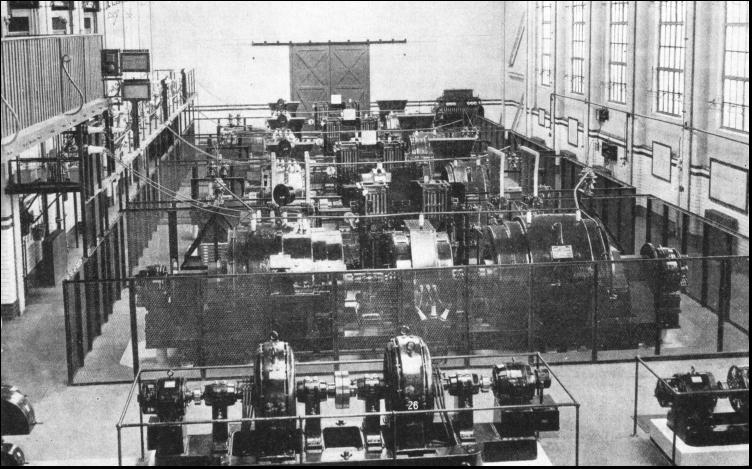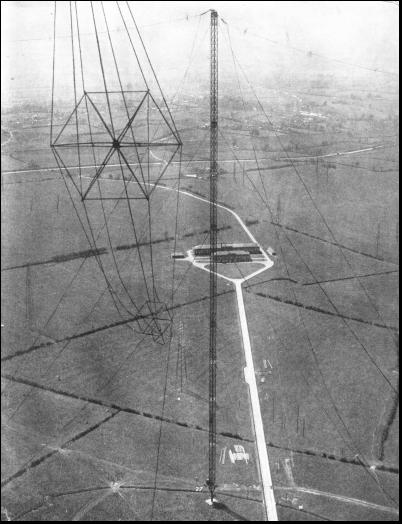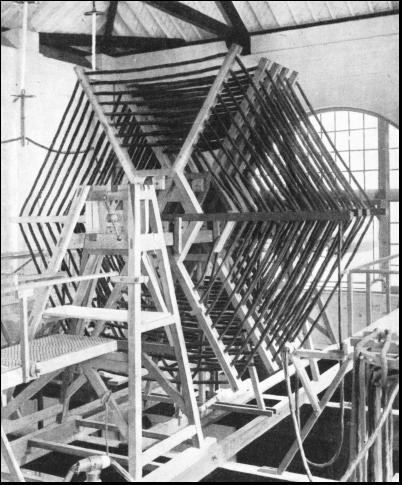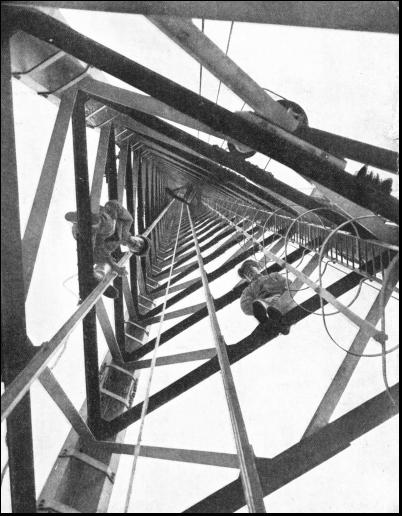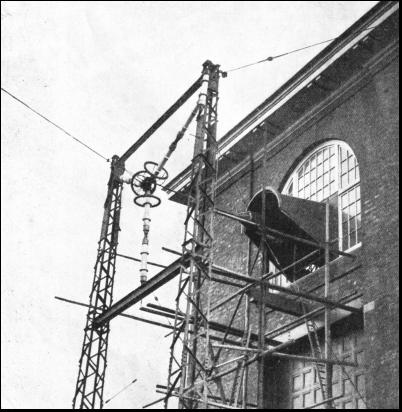|
|
EVERY traveller from London to Chester, whether he uses the London, Midland and Scottish main line or whether he drives up Watling Street, the Roman road, must be familiar with Rugby—the, giant of the ether. He has probably noticed merely a group of towering masts and knows little else about this modern marvel of radio engineering. Possibly he knows vaguely that the masts belong to the G.P.O. Radio Station. Unless he has been conducted over that station he can have no idea of all that Rugby stands for. In 1924 there were 900 acres of farm land between Hillmorton and Kilsby, two villages a few miles south-east of Rugby. A dozen farm buildings, a few trees and a decrepit barn or so were the only landmarks. On January 1, 1926, the Rugby Radio Station began work, and twelve 820-feet masts, their tops sometimes invisible in the clouds, formed the chief outward sign of change. Beneath the masts the station buildings. large as they are, appear insignificant. To-day the same 900 acres are covered with aerials of every conceivable type—a veritable network of wire—and the station is housed in two separate buildings. Ten different transmitters handle between them almost every long-distance telephone call that is made between Great Britain and the rest of the world. If you speak to a friend on board the Queen Mary from your home, your voice is radiated from Rugby ; and through the same station you may talk to North and South America, Africa, Japan, India, Australia or Iceland. Ships at sea compile their daily Press Bulletins from news received direct from Rugby. Rugby was originally designed as a high-powered radio station which would provide reliable telegraphic communication of world-wide range throughout the whole of the twenty-four hours, no matter if conditions were good or bad, and with equal efficacy by day or night. Press news, messages to British ships at sea and private communications were to be handled. At the time of the original conception of the station the short waves had not been proved as a reliable means of communication, and thus Rugby was designed essentially as a long-wave station, working on the wavelength of 18,750 metres. This choice of wavelength was responsible for the building of an aerial nearly two miles long and over 750 feet. high, and the use of higher power than had previously been approached by any radio station in the world. The site near Rugby was chosen because of the absence of hilly or wooded country and road-crossings, and because it was 340 feet above sea level and conveniently situated for London, Birmingham and other large towns and cities. There are few parts of the country in which the main aerial could be erected without obstructions of any kind. The design provided for an aerial suspended on sixteen masts, but only twelve were built. These, however, were so placed that four more could be added when necessary. Calculations and estimates showed that reasonable efficiency, coupled with economical construction, could be obtained with masts 820 feet in height, 70 feet of sag being allowed for at the centre of each span of the aerial. That statement convoys nothing whatever of the engineering feat involved. Each of these masts weighs about 200 tons, stands on a porcelain insulator, houses an electrically-driven lift capable of carrying three people, and has to stand a horizontal strain of some 10 tons at the top, due to the weight of the aerial.
This masts are of lattice steel construction, in the form of a triangle with 10-feet sides. They do not taper, but the scale of the members is decreased at each of the five points to which the stays are attached. These stays, of which there are fifteen to each mast, are anchored to huge blocks of concrete deeply embedded in the ground. Each stay consists of 150 wires, not wound into a cable, but laid parallel and bound together. Each stay is nearly as thick as a man's wrist. Near the foot of each mast, about 30 feet from the ground, is a platform carrying two winches driven by large electric motors. One of these winches carries the halyard for the aerial, and the other operates the lift inside the mast. A ladder inside the mast is also provided for emergency use, but the emergency would need to be acute before one would make use of it. An ascent by lift takes nearly twenty minutes, and it is possible to climb from the lift, by means of a short ladder, on to the top platform of the mast. While one is ascending by the lift, surrounded by the metalwork of the mast, no electrical effects are noticed, but on the open platform at the top everything is "live" when the big transmitter is in operation. One can draw sparks from the brads in one's shoes, and it is easy to read the Morse keying of the transmitter by this means. The aerials, which look insignificant from the ground, are of enormous dimensions. "Sausage" construction is used, six or eight wires being spread out to a diameter of 12 feet by steel spreaders. Huge insulators and guard rings, which have to be inspected at frequent intervals, connect the aerials to the halyards which pass down the centre of the mast. Sparking in Bad WeatherIT is impossible to describe the sensation of height that one obtains from the top of the masts, unless one compares it with that of looking down from an aeroplane. Certainly no high building will give it. These masts are more than twice the height of St. Paul's Cathedral (355 feet), but a mere ten feet in diameter.
The large aerial which they support is used only for the long-wave transmissions, and is led into the station through the centre of a window 7 feet square by means of a copper tube some 20 feet in length. In the early stages of operation, the wooden frame round this window began to char and burn when the transmitter was switched on. Precautions were taken to avoid this, an earthed guard ring being fitted round the window. New difficulties then arose with flashing over (unwanted sparking) in bad weather, and now a huge cowl protects the lead-in from the weather. The charring of the window-frames and the possibility of flashing over at such a distance give some idea of the enormous power fed into the aerial. The normal working value of the aerial voltage is about 165,000. The earth system consists of over 200 miles of buried wire laid out underneath the main aerial. The wires are 50 feet apart, and are buried a few inches below the ground. The transmitter feeding this aerial and earth system is the most powerful telegraphy transmitter in the world. When it was built it was the only transmitter of its class designed for use with valves, all the others operating with arcs or alternators.
News bulletins are broadcast daily to the Empire and to British ships at sea in all parts of the world ; radio-telegrams handed in at any Post Office are transmitted all over the world : and time signals, direct from Greenwich Observatory, are broadcast twice daily for astronomical and navigational purposes, with an accuracy of 1/100th of a second. All this is the work of G B R, which is the highest-powered long-wave transmitter in the world, and has remained virtually unchanged since 1926. The tuning coils of the G B R transmitter arc wound on hexagonal "spiders" roughly 8 feet in diameter and are mounted high up in the roof of the main building. They are wound with Litz (stranded and specially insulated) wire of 6,561 strands, each insulated from its neighbours. The combined wire, which is externally bound with insulation, is more than one inch thick. These coils resemble the "basket" coils that were used so frequently in the early broadcast receivers. Viewed from the floor of the station. 60 feet below, they can be seen to swing as the current flowing round them is "keyed" by the Morse transmitter. Each of the three main power units uses eighteen valves of the most powerful type which was available when the transmitter was built. They are each rated at 10 kilowatts (equivalent to approximately 13 horse-power), and operate with a voltage of 12,000 on their anodes, which are water-cooled. Some fifty gallons a minute pass through each of the three units. The cooling water is taken from specially-built ponds in the station grounds. Two other units are installed, and it is intended, later, to use a single 500-kilowatts valve in one of them. This valve is at present in the experimental stage, and is of the demountable type. In other words, if its filament burns out, the whole thing can be taken to pieces, refitted and evacuated again by pumps permanently installed for the purpose. When it is finally working. this single valve will be capable of handling the entire output of G B R, the long-wave station. The power for this and for the other transmitters is generated on the premises by motor generators, which are installed in a separate part of the building. Four high-tension generators are rated at an output of 500 kilowatts each, three of them giving this output at 6,000 volts and one at 12,000 volts. The generators for the low-tension filament, current. have an output of 200 kilowatts, and in the same engine-house are more than a score of smaller generators for other purposes, including grid-bias. The big transmitters for G B R stand in an orderly row in the main transmitting hall, which is isolated from the generating-room. Nerve Centre of the TransmitterA HIGH standard of safeguarding is enforced, for the protection of the staff and of the apparatus. It is quite impossible for an unauthorized person to get within reach of a "live" part of the transmitter, and the staff themselves cannot possibly make adjustments until everything is completely "dead." These precautions are essential. The power unit cannot be connected to the high-voltage supply until all the, metal gates at the sides of the units have been locked, and their keys locked into the operating switch itself. These keys, for opening the gates, are not released until the switch which earths all parts of the power unit has been operated. A disconnection or a fault in any part of the transmitter automatically makes it impossible for the high-tension switch to be operated. All switching is managed from a central control table which stands in the main hall and forms the nerve centre of the transmitter. The land line from the Central Telegraph Office terminates at this control panel, so that, the signals passing through the transmitter can be checked as they enter. An engine-room telegraph, somewhat similar to that mounted on the bridge of a ship. enables the engineer in charge to signal the power requirements to the power house, and a recorder gives a check on the signals transmitted from the aerial.
The transmitter is controlled entirely by a tuning fork, which is electrically operated. Its output, which is minute. is amplified by means of valves, and harmonics of this frequency are selected and amplified again. One tuning fork is in complete control of the output of several hundred horse-power. The first thing that strikes a visitor to the station is the quietness of the atmosphere—until he visits the generators. In the main transmitting hall one can hear the Morse being sent out, but only because it is being continuously reproduced on loudspeakers for checking purposes. One surprising sound to be heard, however, is that of the ordinary broadcast programme, coming from a hidden loudspeaker but echoing round the building in a most impressive manner. This is not for the entertainment of the engineers, but serves as a check on interference with a local radio-diffusion service. The output of the relay station is fed along a land line to the Rugby transmitting station, and any interference caused by Rugby's transmitters would be instantly noticed by the engineers, who would at once take steps to track it. Long-distance TelephoneAT the end of this same hall is the long-wave telephony transmitter. This is of special interest, since it handled the first international radio-telephone service which could be connected to the ordinary public telephone users' system. It was also the first long-distance radiotelephone service in the world to be brought into regular daily service. By means of what is known as the "single-sideband suppressed-carrier system" the power is made six times as effective as it would be if it were radiated from an ordinary broadcast station. In non-technical language, this means that no power is radiated until the subscriber speaks ; there is no steady carrier-wave on which his voice is superimposed. This transatlantic telephony service works on a wavelength of about 4,500 metres, and is far from being out of date after nearly ten years of operation, since it is more reliable and more independent of etheric conditions than are the more modern short-wave transmitters. The four masts to the north of the main "octagon" support this telephony aerial. The combination of the long- and short-wave systems gives a reliable service to America throughout the twenty-four hours. Unfortunately it is not practicable to operate this long-wave service over greater distances than from England to America, but on the other side of the Atlantic it is linked with telephone and cable services which make it possible for an English subscriber to speak to Canada, Mexico and Cuba as well as to the whole of the United States. All this work is carried out in the main station building, which is perhaps the most impressive part of Rugby because of the spectacular nature of the high powers used, and also because of the enormous dimensions of the aerial system. Two short-wave transmitters working to America, and housed in a small annexe, were opened in August 1928, using wavelengths between 16 and 45 metres. Because of the smaller sizes of aerial necessary for these short waves, it is possible to use highly complicated combinations of wires in the form of aerial arrays and reflectors, commonly known as "beam" systems. By this means the transmissions may be made highly directional, and a great economy of power is effected.
The whole of the 900 acres of land seems to be covered with these beam aerials of every conceivable size and shape, some directed towards America, some towards Australia, and others for Japan, India, Buenos Aires, Rio de Janeiro and almost every quarter of the globe with which Rugby communicates The more modern short-wave equipment is installed in a new building a few hundred yards from the main station. and wires also radiate from the upper windows of this building to the various beam arrays, some of which are more than half a mile distant from the transmitter. Most of the short-wave work is carried out by telephony, and an important part of it is the communication with British and other ships at sea, such as the Queen Mary, Empress of Britain, Bremen, and Europa. The historic broadcasts from the Queen Mary on her maiden voyage were handled through Rugby on the short waves. Since much of the traffic handled on the transatlantic telephone is business of a confidential nature, secrecy is essential. The many thousands of short-wave listeners in Great Britain would otherwise be able to intercept important business conversations. For this reason the telephony is "scrambled" and made quite unintelligible before it. is transmitted from Rugby. The receiving station at the other end is equipped with an "unscrambling" device which restores the speech to its original quality ; but the speech which is radiated through the ether is unrecognizable. Ship-to-shore traffic is not all treated in this way, as only a limited number of ships are fitted with the necessary equipment. In the new building, which houses all the more modern short-wave transmitters, communication may be carried on simultaneously with seven or eight parts of the world. One of the most interesting features to the visitor is the disposition of the aerial connexions at the windows. From the beam arrays long feeder lines are brought to the station, and these terminate in groups of sockets mounted in the glass windows. Swinging the "Beam"UNDERNEATH each group of sockets is a little chart showing their connexions, and at a certain time of day an engineer will quietly switch off the power, ascend the little gallery near the windows, change over two connexions and start the transmitter up again. In a matter of moments the radiated "beam" has been swung round, possibly, from Canada to Japan. It is necessary for the Australian service to reverse its beam at certain times of day, so that the signals are transmitted round the world via the Atlantic Ocean and South America instead of going across Asia. Similarly, the Japanese beam, if reversed, gives a good service to Buenos Aires, which is in an exactly opposite direction from the transmitter. If one is blessed with an acute sense of direction, one may wander round the field at Rugby and hazard intelligent guesses at the parts of the world to which the various aerials are directed. Because of the deceptive nature of maps on Mercator's projection, however, the Japanese, Indian and Australian beams take a far more northerly path than one would imagine. Only by looking at a good globe can one realize that the beam to Australia is projected roughly in the direction of Sweden, and that that for Japan takes an even more northerly path. Some of these beams are suspended from steel towers with large cross-pieces at the top. They are most complicated networks of wires, hung in the form of a curtain, with a similar reflecting "curtain" suspended at a predetermined distance behind them, according to the wavelength for which they are designed. Failure of one of the individual services, because of transmitter breakdown, is guarded against, since nearly all the apparatus is installed in duplicate and so arranged that a quick switchover may be made in the event, of breakdown. This huge station, with all its ramifications and with so many different types of work to be carried on, is smoothly and efficiently run by a total staff of fewer than a hundred men, There is no atmosphere of noise or rush, and it is almost impossible for the visitor to realize that he is in the midst of so much urgent traffic of every type. From the engineers one gathers that the station has its hectic moments occasionally. One hears tales of an ascent of one of the masts late at night in terrible weather to inspect an insulator which is in danger because of the cracking of one of its neighbours. Mention is even made of occasions on which one of the lifts has become temporarily stranded because of the failure of the cable by which its operating motor is fed. The atmosphere, however, is generally one of calm, unhurried efficiency, entirely in keeping with what is a remarkable example of always remarkable radio.
Many thanks for your help
|
   Share this page on Facebook - Share  [email protected] |


